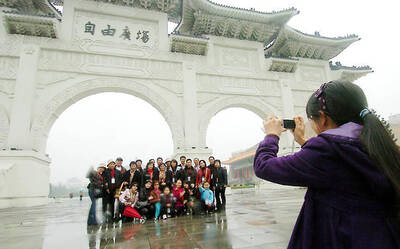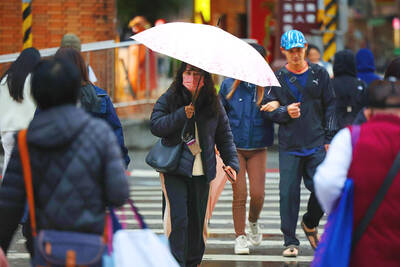The number of foreign students pursuing formal academic degrees in Taiwan has increased significantly in the past four years, with the number of foreign undergraduates almost doubling, according to new statistics released by the Ministry of Education.
For foreign students, the most popular disciplines are banking and finance, business administration, information technology, science and engineering, the statistics show.
Bureau of International Cultural and Educational Relations director Lin Wen-tong (林文通) said students from India are the most noteworthy, as 90 percent of them were pursuing doctorates in chemistry or chemical engineering.
In the last academic year, more than 550 of the 1,497 foreign nationals pursuing doctorates in Taiwan were Indian and an overwhelming majority of them were chemistry or chemical engineering majors, Lin said.
“The trend could be attributed to a long-term talent shortage in those two sectors in India,” he added.
According to the ministry’s statistics, the number of foreign undergraduate students increased to 4,847 in the last academic year, from 2,454 in 2007, when figures for foreign students were last published.
The number of foreign students pursuing master’s degrees also rose from 2,033 to 3,603 in the same period, while the number of doctoral degree candidates more than doubled to 1,497, from 743.
One of the government’s major educational policies has been to try to attract more foreign students, Lin said, adding that the ministry looks forward to seeing the number of students who come from abroad to pursue academic degrees or conduct short-term study programs increase to 130,000 by 2020, from 48,000 in the last academic year.
At present, Southeast Asian nations are the top source of expatriate students pursuing formal academic degrees, while those from China form the bulk of exchange students in short-term study programs.
Lin said students from different countries tend to have different favorite academic disciplines. For instance, students from Southeast Asian nations mostly study banking, finance and business administration.
“Local universities or colleges’ MBA and banking/financing departments have been the top choice for Southeast Asian students,” Lin said. “Perhaps, it’s because their countries were once hard hit by the global financial tsunami and an MBA degree could make it easier for them to find jobs in their home countries after they graduate.”
A breakdown by nationality showed that students from Vietnam tend to study international trade and Thais focus on -pursuing MBAs. Students from Indonesia and Malaysia are mostly ethnic Chinese who opt for the humanities, social sciences, journalism or mass communication.
In contrast, students from the US are mostly interested in studying Chinese language and culture. Japanese students also like to study the humanities and social sciences.
Because Taiwan plays an important role in the global information technology industry, Lin said, an increasing number of young students from eastern European countries such as Romania, Hungary and the Czech Republic have traveled to Taiwan to pursue academic degrees.
Local tertiary education institutions recruited 200 students from Russia after they took part in an education fair in Moscow last year, Lin said.
“We are considering organizing a delegation of local universities to hold education fairs in major eastern European countries to attract more of their young people to study in Taiwan, as part of efforts to expand our education market,” he added.

US climber Alex Honnold is to attempt to scale Taipei 101 without a rope and harness in a live Netflix special on Jan. 24, the streaming platform announced on Wednesday. Accounting for the time difference, the two-hour broadcast of Honnold’s climb, called Skyscraper Live, is to air on Jan. 23 in the US, Netflix said in a statement. Honnold, 40, was the first person ever to free solo climb the 900m El Capitan rock formation in Yosemite National Park — a feat that was recorded and later made into the 2018 documentary film Free Solo. Netflix previewed Skyscraper Live in October, after videos

Starting on Jan. 1, YouBike riders must have insurance to use the service, and a six-month trial of NT$5 coupons under certain conditions would be implemented to balance bike shortages, a joint statement from transportation departments across Taipei, New Taipei City and Taoyuan announced yesterday. The rental bike system operator said that coupons would be offered to riders to rent bikes from full stations, for riders who take out an electric-assisted bike from a full station, and for riders who return a bike to an empty station. All riders with YouBike accounts are automatically eligible for the program, and each membership account

NUMBERS IMBALANCE: More than 4 million Taiwanese have visited China this year, while only about half a million Chinese have visited here Beijing has yet to respond to Taiwan’s requests for negotiation over matters related to the recovery of cross-strait tourism, the Tourism Administration said yesterday. Taiwan’s tourism authority issued the statement after Chinese-language daily the China Times reported yesterday that the government’s policy of banning group tours to China does not stop Taiwanese from visiting the country. As of October, more than 4.2 million had traveled to China this year, exceeding last year. Beijing estimated the number of Taiwanese tourists in China could reach 4.5 million this year. By contrast, only 500,000 Chinese tourists are expected in Taiwan, the report said. The report

Temperatures are forecast to drop steadily as a continental cold air mass moves across Taiwan, with some areas also likely to see heavy rainfall, the Central Weather Administration (CWA) said. From today through early tomorrow, a cold air mass would keep temperatures low across central and northern Taiwan, and the eastern half of Taiwan proper, with isolated brief showers forecast along Keelung’s north coast, Taipei and New Taipei City’s mountainous areas and eastern Taiwan, it said. Lows of 11°C to 15°C are forecast in central and northern Taiwan, Yilan County, and the outlying Kinmen and Lienchiang (Matsu) counties, and 14°C to 17°C